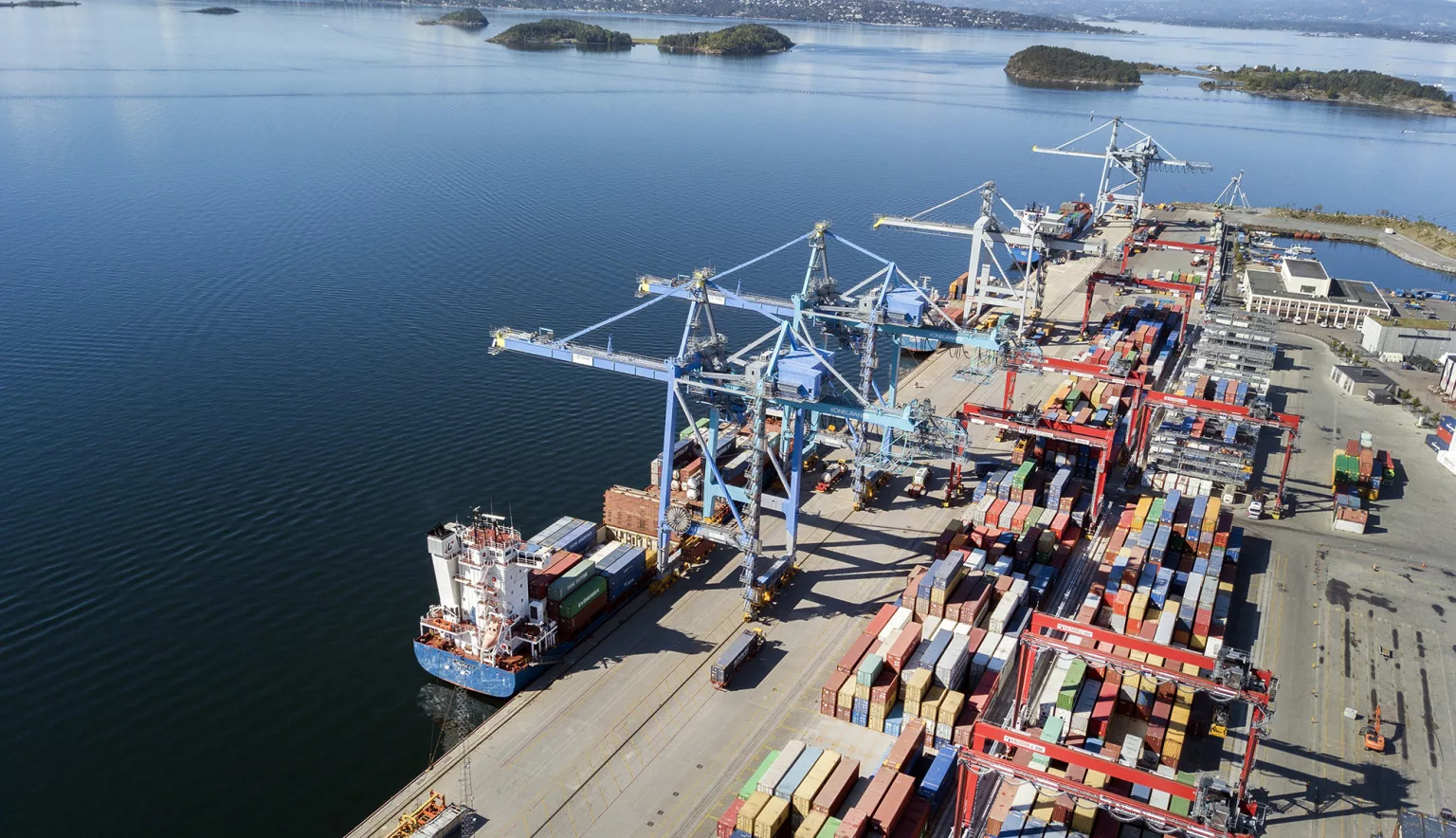In a pursuit of environmental excellence, optimised operational efficiency and growth, Port of Oslo is epitomising the new role of ports via a flurry of innovative initiatives.
CHARTING A NEW COURSE
Global trade is on the up. According to data from the World Bank, the value of exported goods as a share of global GDP rose from 19.3 percent in 1990 to 29.3 percent in 2017.
In tandem with this rise, the role of ports has changed dramatically in recent decades.
Cities that serve as major oceanic transit hubs have come to experience faster growth than their inland counterparts, owed to a rising economic dependence on sea trade that has seen ports become transformed into spatial clusters of innovation, research and development as they strive to meet a new calling.
Indeed, Ingvar Mathisen, CEO and Port Director of Port of Oslo, is one individual well aware of this transition.
“Ports and shipping is an exciting space to be involved in right now,” he states.
“Whether its technological advancements, environment pressures, global political developments or the continued emphasis on improving efficiency and cost, a lot of change is happening.”
For Mathisen, today’s seascape is in many ways entirely different to one that he found upon entering the industry almost a quarter of a century ago.
Opting to fine tune his business acumen when undertaking higher education studies at Pacific Lutheran University in Tacoma in State of Washington in the USA and Nord University in Bodø, Norway, a career in the maritime industry was always his end goal.
“The sector is almost in my genes, so to speak,” he reveals. “On my father’s side, all the men have become seafarers going way back. My father himself ended up working as the CEO of a shipping company, and I was able to hone my hereditary passion through a number of summer jobs at the business.”
Picking up his first full time job back in 1994, working in a marketing capacity for international shipping entity Leif Höegh & Co., the past three decades led Mathisen to numerous jobs and advisory roles across the globe, today heading up one of the world’s most innovative ports.
EMBRACING THE CHALLENGE
In typically progressive Nordic fashion, Oslo is not only embracing but equally spearheading the vast swathes of changes sweeping across the maritime industry.
Climate control plans targeting an 85 percent reduction in greenhouse gas emission by 2030 have been adopted by the City Council, Executive Board of the City of Oslo and Port of Oslo itself, owed to the country’s and indeed region’s growing focus on addressing climate issues.
Coupling this, however, are logistical challenges facing the port – challenges stemming from the strides being made by both Oslo and the industry alike – that are forcing it to take a proactive stance on all fronts.
“Our location is one of our biggest assets,” Mathisen reveals.
“Oslo is one of the Europe’s fastest growing metropolitan areas, and it’s just a six-kilometre round trip between the city centre and the port, meaning we can supply building materials, fuels and other key commodities with ease and with a low carbon footprint.
“On the other hand, as the city grows, the area we’re able to work with shrinks. We’re expecting our 5,700-acre site to roughly half in the coming years, yet at the same time we’re looking to grow our overall cargo business by 50 percent and passenger throughput by 40 percent come 2034.”
Simultaneously shrinking in size, expanding in capacity and becoming more environmentally friendly, it’s a critical time for the Port of Oslo, the organisation reacting accordingly via
a distinct emphasis on innovation.
It’s carbon capture agreement with Fortum Oslo Varme stands as a prime such example.
A collaboration set to be initiated at the Klemetsrud waste-to-energy plant, the goal is to create a chain that will see CO2 captured from industrial processes converted into a liquid form, transported by ship to the west coast of Norway and then transported offshore by pipeline and stored within the seabed in empty oil wells.
“Should all go well, the city can expect to deposit around 400,000 tonnes of liquid carbon in empty oil wells in the North Sea every year beginning 2025,” Mathisen states. “In doing so, we’ll be able to cut the city’s overall emissions by roughly 15 percent.
“What’s great about this project is that nobody’s really done it on a global scale. Should it prove to be a success in Oslo, then it has the potential to have massive implications on the reduction of CO2 emissions worldwide.”
ABUNDANT INVESTMENT
Indeed, it is anticipated that the carbon capture project will also facilitate the growth of a regional waste-to-energy circular economy, the ashes from the burners becoming a key material in development of roads in countries such as Denmark.
“These ashes are becoming something of a commodity, providing the Port of Oslo with the opportunity to expand its export business where traditionally we’ve largely been an imports port,” Mathisen explains.
The carbon capture storage project is just one of numerous examples of innovation in practice at the transport hub, however. Equally, the port is in the final stages of developing an enhanced replacement for its Pelikan work boat, designed specifically to collect waste on the water’s surface both in and around the port.
“The new version will be fully electric and harness sophisticated mapping technologies, improving efficiency and reducing environmental impact of cleanup operations,” the CEO adds.
Owed to these ambitious efforts, it may come as no surprise that Port of Oslo is on track to become one of the world’s first zero-emission ports. Yet its strategic plan extends far beyond this, the firm also pursuing more traditional investments including the maintenance and rehabilitation of its facilities in order to prepare for surges in demand.
Currently the port is in the process of expanding both its passenger and container terminals –necessary improvements considering it has developed capacity for six new container lines and grown roughly 14 percent each year for the past two years.
“We’re also installing a new ship to shore gantry crane and other critical equipment to ensure that we can handle future growth,” Mathisen adds. “By accepting a wider range of cargo, we’re able to move it away from the roads while reducing emissions and congestion, resulting in a win-win situation for all stakeholders.”
CHAMPIONING CHANGE
Investments are not only the way in which Port of Oslo has established an esteemed reputation, however, the Port Director also pointing to his workforce as key champions of its progressive approach.
Having altered the direction of the company along with the direction put forth by the Port’s Board of Directors, Mathisen remains proud of the Port of Oslo team, eluding to their willingness to embrace the challenges that have been accompanied by its broad transition.
“Of course, without dedicated and eager staff, we would be no closer to achieving our goals,” he affirms.
“Port operations and development are ultimately always the core business of the Port of Oslo. Without that, and those who empower it, any of our wider goals would just be like wishes. Our new vision is really something to strive towards: “Port of Oslo – the world’s most efficient and environmentally friendly city near port”. And the staff shall have a clear view of where we are going and are welcoming the changes.”
Supporting its staff is understandably viewed as being of paramount importance to the organisation as a result. And by empowering its HR department internally and working with the City of Oslo externally, it has been able to do so with extensive training programmes and courses.
Higher education is encouraged and in many cases funded by the port itself, providing the platform for individuals to grasp innovations and opportunities arising across the industry.
“We’ve seen many new skills and professions come to the fore of our operations in recent times,” Mathisen continues. “Drone technologies have been implemented of late, for example, used in everything from maintenance assistance and 3D modelling to the identification of potential hazards such as debris and oil spills.”
AN OPTIMISTIC OUTLOOK
Indeed, this recognition of the necessity of proactivity forms the basis of many of Port of Oslo’s goals for the coming years.
While environmental improvements and capacity expansions form a substantial part of the organisation’s long-term targets, the CEO acknowledges that there is a long a road ahead to reaching these objectives and a number of alternate near-term goals will take similar precedence.
“Within our overall strategic plan, we have four strategic objectives,” he affirms.
“Number one is to facilitate and empower a greater level of sea transportation, through enhancing the political policies with regards to sea transport, and reducing the environmental and congestion pressures that come from land-based freight. Number two is to continue to have an effective and well-run port. Number three is to ensure we promote our environmental agenda within sea transport more broadly. And number four is to continue to contribute to Oslo as an attractive city.”
In accordance with these four objectives, the port has equally developed a number of key priorities in an attempt to meet its ambitions, the first of these being a three-pronged approach to the greater appreciation of market, business and customer orientation.
“Improving our work processes and cultivating our business culture comes under this remit,” Mathisen continues. “We hope to continue to empower our people with technologies and give them more responsibility to take ownership of these new directions.”
This, combined with improved competencies, accelerated development and bolstered local and international stature, will dictate busy times ahead for Port of Oslo. Yet the sheer number initiatives underway speaks volumes of the organisation’s optimism – optimism cited by Mathisen in his concluding statements.
He affirms: “In previous years, there have been times when we haven’t expanded, and in some cases contracted. But right now, we’re growing tremendously.
“In 2017 we catered for roughly 207,000 twenty-foot equivalents (TEUs). Last year we had 238,000.
And this year we’re on track to hit somewhere around the 270,000 mark.
“Yet at the same time, this is not a temporary surge. Rather, it stems from a structural change. Continental Europe is lacking tens of thousands of truck drivers, making land transport scarcer and more expensive and subsequently paving the way for the shipping industry to begin to come to the fore.
“Shipping has become more competitive and, in many ways, it is the future – because the seaway is the environmental friendly way.”





















